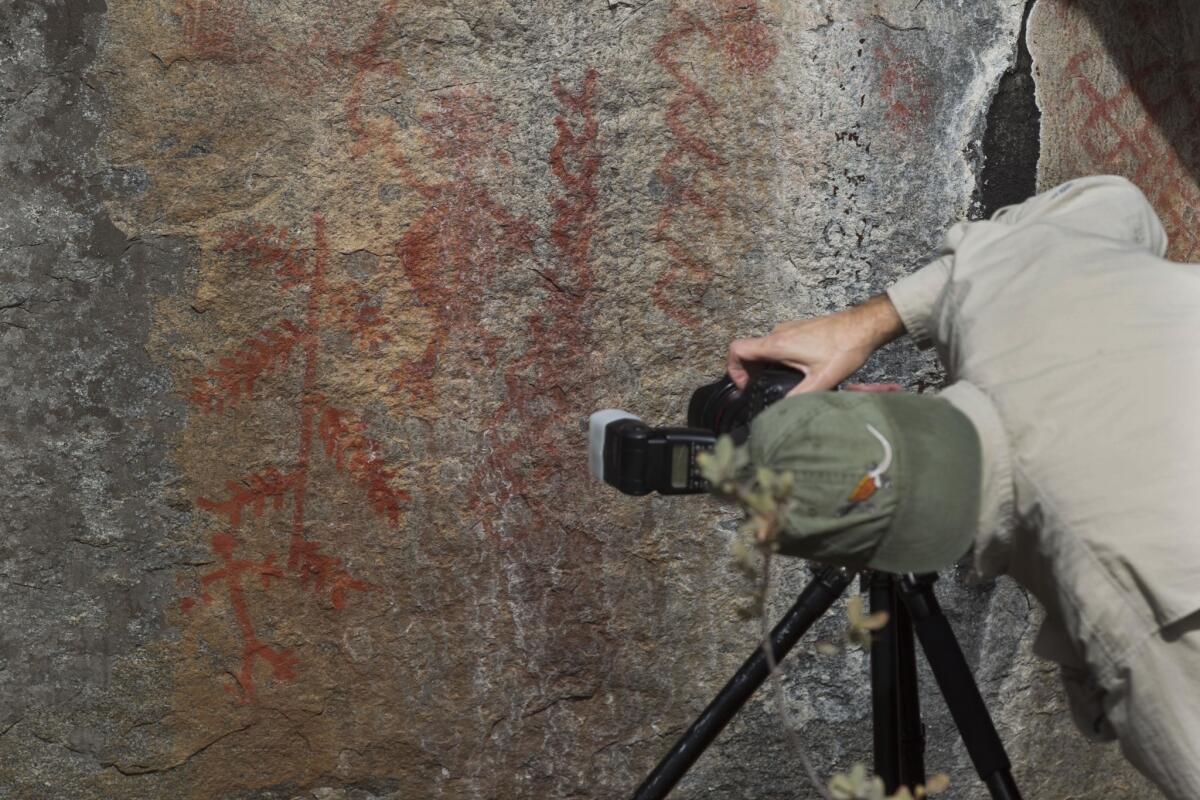Deciphering the ‘remarkable’ pictographs in remote San Diego County

A “remarkable” pictograph site that could date back to the 1700s is hidden on the side of a large boulder in one of the most secluded places in San Diego County, Native American art experts say.
Dozens of drawings cover the 26-foot-wide rock in the heart of a massive former land grant called Rancho Guejito in northeastern San Diego County. One drawing appears to be a conquistador raising a sword and wearing an armored chest plate. Beneath him, perhaps protected by a group of eagle feathers, is a stick figure that could represent a Native American who has been slain or is being threatened.
“It’s an incredibly unusual design,” said Steve Freers, a Native American art expert who — along with former San Diego Museum of Man curator Ken Hedges — was hired earlier this year by Rancho Guejito’s owners to examine the pictographs.
The ranch is the last undeveloped, privately owned Mexican land grant left in the United States. The pictographs are in an area of the property that’s an hour’s drive from the nearest paved road. The drawings originally were documented by an archaeologist in 1960, then largely forgotten.
“It’s a site we had heard exists but haven’t had access to for all these years,” said Hedges, who also is an archaeologist. “It’s really exciting to see it.”
Some of the drawings — representing three different styles and Native American cultures — suggest that the area may have been used as as a haven for Indian tribes trying to escape the European invasion that began in 1769.
The rancho’s chief operating officer, Hank Rupp, said the pictographs appear to capture a pivotal time in the region’s history.
“I believe what you’re seeing here is a depiction of Native American unhappiness with the Spanish invasion at San Diego,” Rupp said. “The Spanish conquistadors … came with their church and attempted to foist it on the Native Americans.”
A report prepared by Freers and Hedges said speculation that the figure could be a Spanish soldier is “plausible.”
They said the drawings could be analogous to Kumeyaay paintings in Baja California determined to have been painted around the same time the conquistadors would have been around.
“The hand implement could be a sword raised in dramatic display,” they said in the report, noting that the body started out as a stick figure but was broadened in the torso area, possibly to give the impression of armor.
Both men have strongly recommend that further studies be done on the drawings to verify their origin. If the pictographs had been found on public land — a state park for instance — state archaeologists would take control. But because the ranch is privately owned, further study would have to be done at the owner’s request.
Rupp said more studies are planned, in consultation with experts and local Native American tribes.
“We are cataloging numerous archaeological sites on the ranch for the purpose of knowing where they are, determining what, if anything, needs to be done to preserve them, and to communicate with our Native American partners,” Rupp said.
He said Rancho Guejito — which sits roughly between state routes 76 and 78 in Valley Center — works hard to keep out trespassers and others who might damage culturally significant areas.
“We patrol the ranch with armed guards,” Rupp said. “We are going to do everything we can to protect Native American and California history.”
The sprawling property has changed little over the last few centuries, since Spain’s King Charles III directed Gaspar de Portola in 1769 into what is now present-day California. Accompanied by a group of Franciscans led by Junipero Serra, the plan was to establish a string of missions along the coast from San Diego to Monterey Bay.
One of the prime reasons for creating the mission system was to convert the region’s indigenous population to Christianity. Anywhere from 133,000 to more than 700,000 Native Americans — representing more than 100 tribes — were contacted by the Spanish over the next 50 years, according to historical records.
Rupp said De Portola’s march up the coast, from 1769 to 1770, would have taken place about eight miles west of where the drawings were found on Rancho Guejito.
The next step in documenting and studying the pictographs will be carbon dating, to determine when the art was created, Rupp said. Freers and Hedges also have recommended that experts assess the area and search for signs of a village.
“Usually villages are associated with rock art within a quarter-mile,” Freers said. “This is too remarkable to be just a stop on a trail.”
jharry.jones@sduniontribune.com
Jones writes for the San Diego Union-Tribune
More to Read
Sign up for Essential California
The most important California stories and recommendations in your inbox every morning.
You may occasionally receive promotional content from the Los Angeles Times.










